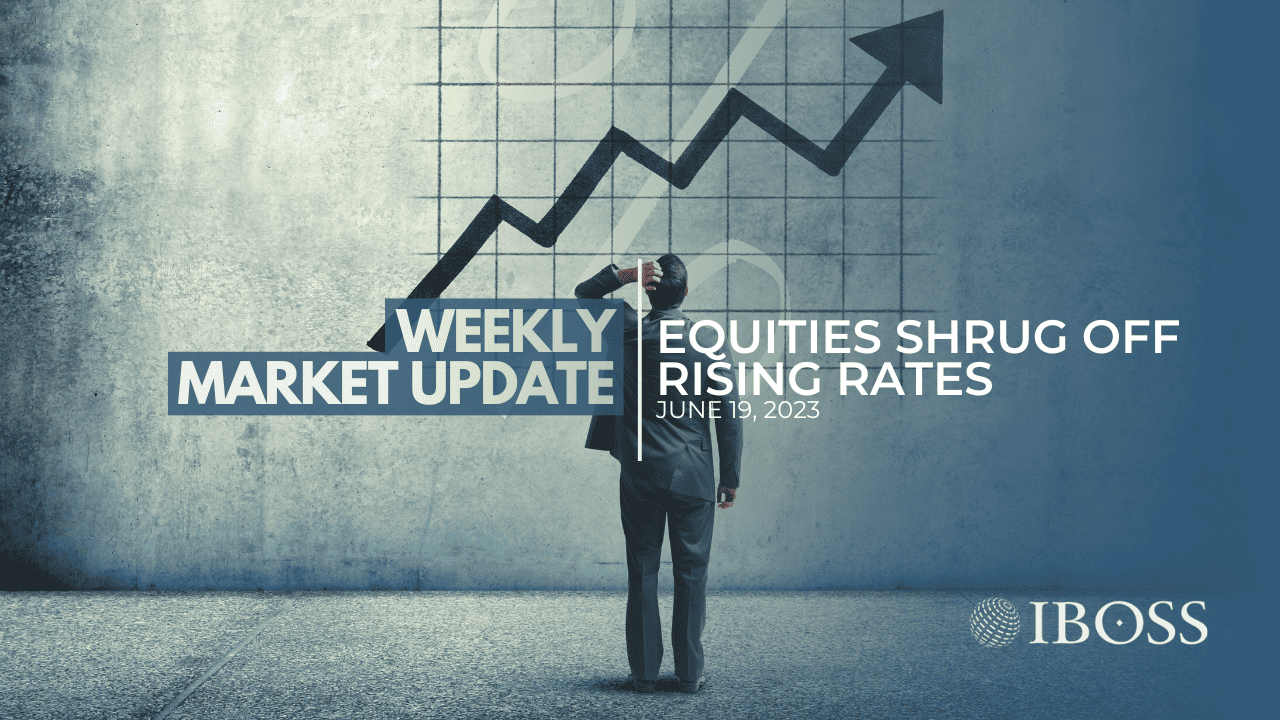
Last week was a good one for global equities. They gained 2.4% in local currency terms and a more muted 0.8% in sterling terms as the pound rallied to $1.28 against a weaker dollar.
Meanwhile, bond yields moved higher. The rise was limited other than in the UK where they increased 0.2% with short dated gilt yields breaking above last October’s mini-budget high and hitting 5.0%.
Events in the US as ever were the main focus and the week started with the May inflation numbers which saw no big surprises. Headline inflation slowed considerably from 4.9% to 4.0% but the improvement in the core rate to 5.3% from 5.5% was much smaller.
Centre stage was the Fed meeting which ended up giving a rather confused message, more akin to what we associate with a central bank rather closer to home. The Fed left rates unchanged at 5-5.25% as expected. Instead, the surprise was that, despite deciding to pause this month, it is now forecasting two more rate hikes later this year, rather than just one as previously.
This was accompanied by an upward revision to the Fed’s growth and inflation forecasts for this year. It now sees core inflation still remaining at 3.9% by year-end and not returning close to its 2% target until 2025. At the same time, it still seems to believe a recession can be avoided with growth forecast to be around 1% both this year and next.
The end result was that the market has now largely abandoned its hopes for rate cuts later this year. These had always looked decidedly premature given the Fed’s repeated denial in recent months of any such plans.
There was no such mixed message from the ECB. It raised rates on Thursday another 0.25% to 3.5% and said a further 0.25% hike in July was very likely. It too raised its inflation forecast and expects no return to 2% before 2025. Despite the economy already dicing with recession, rates could well be raised yet again in September.
The BOE meets this Thursday and a 0.25% rise to 4.75% looks highly likely with an outside chance of a 0.5% hike. The case for further tightening was already strong following the surprise jump in core inflation in April to a new high of 6.8% and last week’s labour market numbers reinforced the case.
Regular wage growth unexpectedly picked up to 6.5%, with wages in the private sector up 7.6% on a year ago. Fears of a wage-price spiral, or more accurately this time a price-wage spiral, have intensified as a result.
The market now expects bank rate to peak as high as 5.75%-6%. While this seems a bit of an over-reaction, rates do look set to rise to at least 5.25-5.5%. The effect anyway has been to trigger a jump in mortgage rates, with rates on two to five year fixed rate deals hitting 5.5-6%.
With more than 2.4mn fixed rate deals expiring by the end of next year, this is once again stirring up recession fears. As yet, however, the picture remains more one of stagnation. GDP inched up 0.1% in the three months to April and business confidence remains well above recession levels. Furthermore, while the pain from higher rates is intensifying, the squeeze on real wages has eased as earnings growth has picked up and inflation has started to slow.
The comments so far have been entirely focused on the West and how much further rates need to rise. But China is in a very different situation. The question here is not how much policy will be tightened but how much it will be relaxed to support the post-covid recovery, with the recent economic activity numbers for May all disappointing.
Encouragingly, the central bank has cut its main policy rate by 0.1% for the first time since last August and further monetary and fiscal stimulus should be forthcoming. The other positive development was US Secretary of State Blinken’s visit to China which may signal some easing in US-China tensions.
All this led to China being the best performing major equity market last week and we continue to believe it has greater upside potential than its geopolitical rival.
This communication is designed for professional financial advisers only and is not approved for direct marketing with individual clients. These investments are not suitable for everyone, and you should obtain expert advice from a professional financial adviser. Investments are intended to be held over a medium to long term timescale, taking into account the minimum period of time designated by the risk rating of the particular fund or portfolio, although this does not provide any guarantee that your objectives will be met. Please note that the content is based on the author’s opinion and is not intended as investment advice. It remains the responsibility of the financial adviser to verify the accuracy of the information and assess whether the OEIC fund or discretionary fund management model portfolio is suitable and appropriate for their customer.
Past performance is not a reliable indicator of future performance. The value of investments and the income derived from them can fall as well as rise, and investors may get back less than they invested.
IBOSS Asset Management is authorised and regulated by the Financial Conduct Authority. Financial Services Register Number 697866.
IBOSS Asset Management Limited is ultimately owned by Kingswood Holdings Limited, an AIM Listed company incorporated in Guernsey (registered number: 42316).
Registered Office: 2 Sceptre House, Hornbeam Square North, Harrogate, HG2 8PB. Registered in England No: 6427223.
IAM 180.6.23
